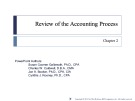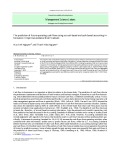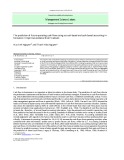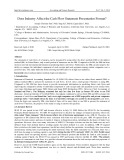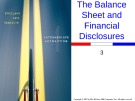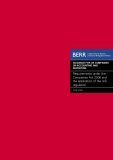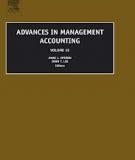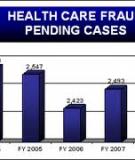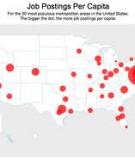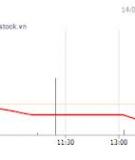
Predicting future cash flows
-
Lecture Intermediate accounting - Chapter 2: Review of the accounting process. Chapter 1 stressed the importance of financial statements in helping investors and creditors predict future cash flows. The balance sheet, along with accompanying disclosures, provides relevant information useful in helping investors and creditors not only to predict future cash flows, but also to make the related assessments of liquidity and long-term solvency.
 32p
32p  haojiubujain05
haojiubujain05
 27-07-2023
27-07-2023
 3
3
 3
3
 Download
Download
-
This research was conducted for assessing the predictive ability of future cash flows from operating activities by using accounting earnings and cash flows information in the past. Data were collected from the firms listed on Ho Chi Minh Stock Exchange (HOSE) from 2009 to 2018, including the sample of 242 non-financial listed companies.
 12p
12p  tozontozon
tozontozon
 25-04-2020
25-04-2020
 13
13
 3
3
 Download
Download
-
This research was conducted for assessing the predictive ability of future cash flows from operating activities by using accounting earnings and cash flows information in the past. Data were collected from the firms listed on Ho Chi Minh Stock Exchange (HOSE) from 2009 to 2018, including the sample of 242 non-financial listed companies. Three statistical methods approaches were employed to address econometric issues and to improve the accuracy of the regression coefficients based on Ordinary Least Squares (OLS), Random Effects Model (REM), and Fixed Effects Model (FEM).
 12p
12p  tociitocii
tociitocii
 18-04-2020
18-04-2020
 16
16
 1
1
 Download
Download
-
The statement of cash flows of a business can be presented by using either the direct method (DM) or the indirect method (IM). In United States, only a small portion of businesses use the DM. Compared to the IM, the DM has been shown to provide incremental information in predicting future cash flows.
 8p
8p  vimadrid2711
vimadrid2711
 18-12-2019
18-12-2019
 16
16
 0
0
 Download
Download
-
Chapter 3 - The Balance sheet and financial disclosures. The balance sheet, along with accompanying disclosures, provides relevant information useful in helping investors and creditors not only to predict future cash flows, but also to make the related assessments of liquidity and long-term solvency. The purpose of this chapter is to provide an overview of the balance sheet and financial disclosures and to explore how this information is used by decision makers.
 38p
38p  whocare_e
whocare_e
 04-10-2016
04-10-2016
 44
44
 2
2
 Download
Download
-
Research Objectives: Review and summarize systematically theories on features of cash accounting based information and accrual accounting based information; examine the predictive abilities of future operating cash flow by using earnings.
 12p
12p  change01
change01
 05-05-2016
05-05-2016
 45
45
 1
1
 Download
Download
-
A simple model of earnings, cash flows and accruals is developed by assuming a random walk sales process, variable and fixed costs, accounts receivable and payable, and inventory and applying the accounting process. The model implies earnings better predicts future operating cash flows than does current operating cash flows and the difference varies with the operating cash cycle. Also, the model is used to predict serial and crosscorrelations of each firm's series. The implications and predictions are tested on a 1337 firm sample over 1963-1992.
 53p
53p  bin_pham
bin_pham
 06-02-2013
06-02-2013
 49
49
 4
4
 Download
Download
-
We directly test our contracting arguments' and simple model's that earnings by itself is a better forecast of future operating cash flows than current operating cash flows by itself. The test uses earnings and cash flows individually as forecasts of one-to three-yearahead operating cash flows. Since this test does not require estimation of any parameters, all forecasts are out of sample. We also test the proposition that the forecasting superiority of current earnings relative to current operating cash flows increases with the operating cash cycle, 8.
 46p
46p  bin_pham
bin_pham
 06-02-2013
06-02-2013
 41
41
 3
3
 Download
Download
-
In this section we develop a simple model of operating cash flows and the accounting process by which operating cash flow forecasts are incorporated into accounting earnings. The model explains why operating cash flow changes have negative serial correlation and how earnings incorporate the negative serial correlation to become a better forecast of future operating cash flows than current operating cash flows. The model also explains other time series properties of earnings, operating cash flows and accruals.
 30p
30p  bin_pham
bin_pham
 06-02-2013
06-02-2013
 65
65
 4
4
 Download
Download
-
The effects of accruals on the time series properties of annual earnings and the predictability of future cash flows are likely to be more readily observable for working capital accruals. For the majority of firms the cycle from outlay of cash for purchases to receipt of cash from sales (which we call the "operating cash cycle") is much shorter than the cycle from outlay of cash for long-term investments to receipt of cash inflows from the investments (the "investment cycle").
 38p
38p  bin_pham
bin_pham
 06-02-2013
06-02-2013
 46
46
 3
3
 Download
Download
-
We also expect inclusion of verifiable anticipated future cash flows and matching of outflows to increase earnings' ability to predict future cash flows so that current earnings is a better predictor of future cash flows than are current cash flows. We provide support for both expectations in the simple model of firms' cash flows, accruals and earnings presented in the next section (section 3).
 151p
151p  bin_pham
bin_pham
 06-02-2013
06-02-2013
 49
49
 5
5
 Download
Download
-
This section discusses the development of the contracting literature and contractual uses of accounting. It develops implications for relative abilities of earnings and cash flows to forecast future cash flows and for the times series properties of earnings and cash flows. The modern economic theory of the firm views the firm as a set of contracts between a multitude of parties. The underlying hypothesis is that the firm's "contractual designs, both implicit and explicit, are created to minimize transactions costs between specialized factors of production" (Holmstrom and Tirole, 1989, p.
 50p
50p  bin_pham
bin_pham
 06-02-2013
06-02-2013
 54
54
 3
3
 Download
Download
-
The next section discusses contractual use of accounting earnings and implications for the inclusion of cash flow forecasts in earnings and the relative abilities of earnings and cash flows to forecast future earnings. Section 3 models operating cash flows and the accounting process by which operating cash flow forecasts are incorporated in earnings.
 53p
53p  bin_pham
bin_pham
 06-02-2013
06-02-2013
 56
56
 5
5
 Download
Download
-
Based on the discussion of contracting's implications for earnings calculation, we model operating cash flows and the formal accounting process by which forecasted future operating cash flows are incorporated in earnings. The modeling enables us to generate specific integrated predictions for: i) the relative abilities of earnings and operating cash flows to predict future operating cash flows; and ii) firms' time series properties of operating cash flows, accruals and earnings. We also predict cross-sectional variation in the relative forecast-abilities and correlations.
 0p
0p  bin_pham
bin_pham
 06-02-2013
06-02-2013
 49
49
 3
3
 Download
Download
-
Fund managers will be seeking to understand the dynamics of the business in which the company operates and in particular, potential growth rates into the future. The track record of the company and its senior executives will be of importance. ‘Quality of earnings’ will often govern how much a fund manager will pay for a particular share. A predictable earnings stream and growth trajectory is of great value. Corroboration of profit and loss account by strong and predictable cash-flow is important.
 0p
0p  bocapchetnguoi
bocapchetnguoi
 06-12-2012
06-12-2012
 67
67
 2
2
 Download
Download
-
We use discretionary accruals as a measure of earnings quality (Beneish and Vargus, 2002; Chan, Chan, Jegadeesh, and Lakonishok, 2006). According to the accounting identity, earnings are equal to cash flows plus accruals. Accruals are accounting adjustments designed to better reflect firms’ fundamental operations. However, accruals are subject to managers’ discretion, which may distort reported earnings.
 21p
21p  quaivattim
quaivattim
 04-12-2012
04-12-2012
 68
68
 1
1
 Download
Download
-
Instruments used to predict future mutual fund returns include the aggregate dividend yield, the default spread, the term spread, and the yield on the three-month T-bill, variables identified by Keim and Stambaugh (1986) and Fama and French (1989) as important in predicting U.S. equity returns. The dividend yield is the total cash dividends on the value- weighted CRSP index over the previous 12 months divided by the current level of the index. The default spread is the yield differential between Moodys BAA-rated and AAA- rated bonds.
 134p
134p  quaivatdo
quaivatdo
 19-11-2012
19-11-2012
 70
70
 9
9
 Download
Download
-
CHAPTER 7 Earnings and Cash Flow Analysis Cash flow is a company’s lifeblood, and for a healthy company the primary source of cash flow is earnings. Little wonder that security analysts are obsessed with both. Their goal is to predict future earnings and cash flow.
 48p
48p  summerflora
summerflora
 27-10-2010
27-10-2010
 59
59
 9
9
 Download
Download
-
CHAPTER 6 Common Stock Valuation A fundamental assertion of finance holds that a security’s value is based on the present value of its future cash flows. Accordingly, common stock valuation attempts the difficult task of predicting the future. Consider that the average dividend yield for large-company stocks is about 2 percent.
 56p
56p  summerflora
summerflora
 27-10-2010
27-10-2010
 62
62
 8
8
 Download
Download
CHỦ ĐỀ BẠN MUỐN TÌM








